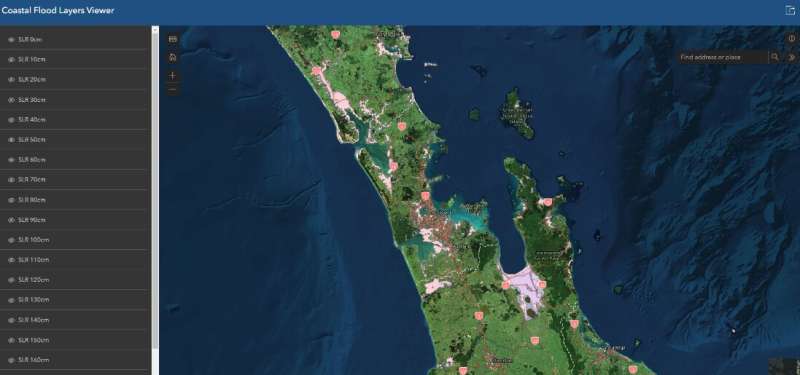New maps reveal places at risk from sea-level rise
New maps from NIWA and the Deep South National Science Challenge show areas across Aotearoa New Zealand that could be inundated by extreme coastal flooding. They show a large storm-tide with the sea-level rise that we are likely to see with climate change.
NIWA’s Chief Scientist for Coasts and Estuaries Dr. Scott Stephens says that these maps will help shape decisions on how we adapt to sea-level rise.
“Coastal flooding is a global hazard that impacts New Zealand, with rising sea levels already causing more frequent and intense flooding along many coasts. We have created maps that help identify the changing risk to land, property, and infrastructure from rising seas, at a regional and national scale.
“We hope this information will raise awareness and help councils and government to know where to conduct detailed investigations when developing adaptation strategies to protect our coastal communities,” said Dr. Stephens.
The maps are also intended to help the financial industry, national infrastructure, and service providers to risk assess their portfolios.
“It’s difficult to make decisions about the future if you can’t see it—these maps provide a window into the future,” said Dr. Stephens.
Coastal flooding is particularly likely when high tides, storm surges and large waves occur simultaneously. At these times, low-lying areas are inundated when high seas overtop or even break barriers, and cause rivers to back up inland.
This can destroy property, infrastructure, and be a danger to life, as well as having severe impacts on the natural environment and ecosystems.
“With much of our major infrastructure and roughly 65% of New Zealanders living within 5km of the coast, this is an issue that will impact many of us, so we must be aware of what’s coming and be prepared to adapt.”
“These maps are not designed for assessing exposure to individual properties, however. Many councils have more detailed maps for that purpose. The advantage is that they fill in gaps for areas of the country that don’t currently have this data available, they provide nationwide information, and they include many scenarios of sea-level rise,” said Dr. Stephens.
The maps were used in new research that examined New Zealand’s increasing exposure to coastal flooding with sea-level rise.
The research found that small amounts of sea-level rise will drive a rapid increase in cumulative flooding from increasingly frequent coastal-flood events-nationally, and 30% more land area would be regularly flooded after 0.3m relative sea-level rise.
“By 2065, there could be 0.4m of sea-level rise, based on the current trajectory, or sooner where the landmass is subsiding,” said Dr. Stephens.
The maps can be viewed, and data downloaded at https://niwa.co.nz/natural-hazards/our-services/extreme-coastal-flood-maps-for-aotearoa-new-zealand.
Citation:
New maps reveal places at risk from sea-level rise (2023, May 25)
retrieved 25 May 2023
from https://phys.org/news/2023-05-reveal-sea-level.html
This document is subject to copyright. Apart from any fair dealing for the purpose of private study or research, no
part may be reproduced without the written permission. The content is provided for information purposes only.

New maps from NIWA and the Deep South National Science Challenge show areas across Aotearoa New Zealand that could be inundated by extreme coastal flooding. They show a large storm-tide with the sea-level rise that we are likely to see with climate change.
NIWA’s Chief Scientist for Coasts and Estuaries Dr. Scott Stephens says that these maps will help shape decisions on how we adapt to sea-level rise.
“Coastal flooding is a global hazard that impacts New Zealand, with rising sea levels already causing more frequent and intense flooding along many coasts. We have created maps that help identify the changing risk to land, property, and infrastructure from rising seas, at a regional and national scale.
“We hope this information will raise awareness and help councils and government to know where to conduct detailed investigations when developing adaptation strategies to protect our coastal communities,” said Dr. Stephens.
The maps are also intended to help the financial industry, national infrastructure, and service providers to risk assess their portfolios.
“It’s difficult to make decisions about the future if you can’t see it—these maps provide a window into the future,” said Dr. Stephens.
Coastal flooding is particularly likely when high tides, storm surges and large waves occur simultaneously. At these times, low-lying areas are inundated when high seas overtop or even break barriers, and cause rivers to back up inland.
This can destroy property, infrastructure, and be a danger to life, as well as having severe impacts on the natural environment and ecosystems.
“With much of our major infrastructure and roughly 65% of New Zealanders living within 5km of the coast, this is an issue that will impact many of us, so we must be aware of what’s coming and be prepared to adapt.”
“These maps are not designed for assessing exposure to individual properties, however. Many councils have more detailed maps for that purpose. The advantage is that they fill in gaps for areas of the country that don’t currently have this data available, they provide nationwide information, and they include many scenarios of sea-level rise,” said Dr. Stephens.
The maps were used in new research that examined New Zealand’s increasing exposure to coastal flooding with sea-level rise.
The research found that small amounts of sea-level rise will drive a rapid increase in cumulative flooding from increasingly frequent coastal-flood events-nationally, and 30% more land area would be regularly flooded after 0.3m relative sea-level rise.
“By 2065, there could be 0.4m of sea-level rise, based on the current trajectory, or sooner where the landmass is subsiding,” said Dr. Stephens.
The maps can be viewed, and data downloaded at https://niwa.co.nz/natural-hazards/our-services/extreme-coastal-flood-maps-for-aotearoa-new-zealand.
Citation:
New maps reveal places at risk from sea-level rise (2023, May 25)
retrieved 25 May 2023
from https://phys.org/news/2023-05-reveal-sea-level.html
This document is subject to copyright. Apart from any fair dealing for the purpose of private study or research, no
part may be reproduced without the written permission. The content is provided for information purposes only.
